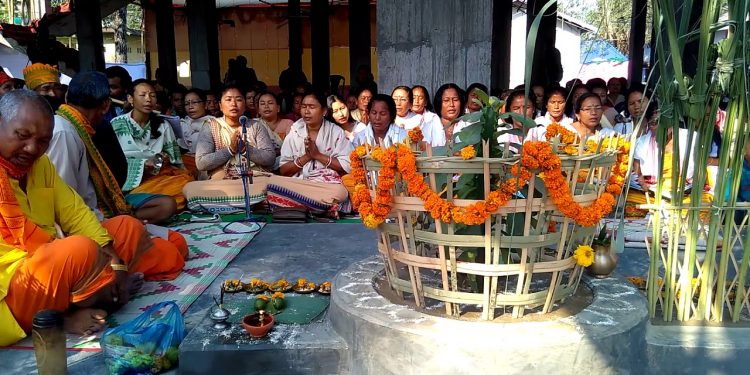
Introduction
Bathow Puja is a significant religious festival celebrated by the Bodo-Kachari community of Assam, India. It is a form of ancestral and natural worship where people offer prayers to their supreme deity, Bathow Bwrai, who is regarded as the protector of the universe. The festival is deeply rooted in the culture, traditions, and religious beliefs of the Bodo-Kachari people and is considered one of the most important ceremonies in their spiritual life.
Who is Worshipped in Bathow Puja?
The primary deity worshipped during Bathow Puja is known by several names, including:
- Bathow Bwrai – The Supreme God of the Bodo-Kachari people.
- Gila Damra – A form of the divine associated with protection and strength.
- Khuria Bwrai – Another name used in different regions.
- Sri Brai (Shibbwrai) – Some identify this form of the deity with Lord Shiva from Hindu beliefs.
While many associate Bathow Bwrai with Lord Shiva, the Bodo-Kacharis have their distinct religious identity and beliefs, making this festival unique.
The Significance of Bathow Puja
Bathow Puja is not just a religious ceremony; it holds deep cultural and spiritual significance:
- It represents the worship of nature, with the Sijou plant (Euphorbia milii) symbolizing the deity. This plant is considered sacred and is planted inside a fenced altar called the Bathow Thansali.
- The festival is a way of honoring ancestors and seeking blessings for prosperity and well-being.
- The rituals and offerings reflect the close connection between the Bodo-Kacharis and nature.
Different Forms of Bathow Puja
There are various forms of Bathow Puja, each with its unique significance and rituals. The three main types are:
1. Garja Festival
Garja is a ritual performed to ward off evil spirits and bring prosperity. It is usually organized in villages when people believe there is an outbreak of disease or any other misfortune. During this ritual, animals such as pigs and fowls are sacrificed to appease the deities.
2. Kherai Puja (The Most Important Festival)
Kherai Puja is the most significant form of Bathow worship. It is performed with great devotion and elaborate rituals, usually in an open field or at the Bathow altar.
- The priest, known as the Douri (male) or Doudini (female), leads the rituals and performs dances while in a trance-like state.
- Offerings of rice beer, rice, flowers, and animal sacrifices are made to please the deity.
- The festival includes traditional Bodo music and dance, making it a grand community event.
3. Marai Puja
Marai Puja is performed for the well-being of the entire community. This ritual involves collective participation, and prayers are offered for agricultural prosperity and protection from natural calamities.
Rituals and Celebrations
Bathow Puja is celebrated with elaborate rituals that include:
- Installation of the Sijou Plant: The plant is planted inside the Bathow Thansali and worshipped as the embodiment of the deity.
- Offering of Prayers and Sacrifices: People offer rice, milk, sugarcane, and animals as sacrifices.
- Chanting of Hymns and Traditional Dance: Priests and devotees chant hymns in the Bodo language and perform traditional dances.
- Community Feast: The festival concludes with a grand feast where people share food and celebrate together.
How Bathow Puja Differs from Other Religious Festivals
What makes Bathow Puja unique compared to other religious festivals in India?
- Worship of the Sijou Plant: Instead of idols or temples, Bodo-Kacharis worship a living plant as their deity.
- Connection to Nature: The rituals emphasize harmony with nature and involve no idol worship, setting it apart from mainstream Hindu festivals.
- Trance Dance Rituals: The unique dance performances by the priest or priestess while in a trance are rare in other religious celebrations.
- Animal Sacrifices with Traditional Beliefs: Unlike many modern Hindu practices, Bathow Puja still follows age-old traditions of sacrifice as an offering to deities.
Modern Adaptations and Influence
With time, Bathow Puja has also undergone changes. Many Bodo-Kacharis living in urban areas have adapted their worship methods to fit modern lifestyles. While animal sacrifices have become less common in some places, the core rituals of offering prayers to the Sijou plant and performing traditional dances remain unchanged.
Additionally, efforts are being made to promote Bathow Puja beyond Assam, ensuring that the younger generation remains connected to their roots and cultural heritage.
Conclusion
Bathow Puja is more than just a festival—it is a celebration of faith, nature, and cultural identity. Deeply embedded in the traditions of the Bodo-Kachari people, it continues to be a symbol of unity and devotion. Unlike other religious festivals, its uniqueness lies in its nature worship, community participation, and spiritual dances. As the world modernizes, Bathow Puja stands as a reminder of the importance of preserving indigenous traditions and respecting the sacred bond between humans and nature.
FAQ’s
Q. What is Bathow Puja?
Bathow Puja is a traditional religious festival of the Bodo-Kachari community in Assam, India. It is dedicated to Bathow Bwrai, the supreme deity of the Bodos, who is considered the protector of the universe. The festival is deeply connected to nature worship, and the Sijou plant (Euphorbia milii) is regarded as a symbolic representation of the deity.
Q. Who is Bathow Bwrai?
Bathow Bwrai is the supreme god of the Bodo-Kacharis. He is known by different names, including Gila Damra, Khuria Bwrai, and Sri Brai (Shibbwrai). Some people associate him with Lord Shiva, but Bodo religious traditions remain distinct from mainstream Hinduism.
Q. What is the significance of the Sijou plant in Bathow Puja?
The Sijou plant (Euphorbia milii) is considered sacred and is planted inside a fenced altar called Bathow Thansali. It symbolizes Bathow Bwrai and represents the five natural elements—earth, water, air, fire, and sky—signifying the connection between humans and nature.
Q. What are the different types of Bathow Puja?
There are three main types of Bathow Puja:
Garja Puja – Performed to ward off evil spirits and misfortunes.
Kherai Puja – The most important form, involving trance rituals and community celebrations.
Marai Puja – Conducted for the well-being of the entire community, especially for agricultural prosperity.
Q. When and where is Bathow Puja celebrated?
Bathow Puja is primarily celebrated in Bodo-majority areas of Assam, such as Kokrajhar, Baksa, Chirang, and Udalguri. While it does not have a fixed date, it is performed based on traditional customs, usually during the harvest season or special occasions.
Q. How can visitors experience Bathow Puja?
Tourists and outsiders can witness Bathow Puja in Bodo-majority villages in Assam, especially during public celebrations of Kherai Puja. Many cultural festivals also feature Bodo music, dance, and rituals, allowing visitors to experience the rich traditions of the Bodo-Kachari people.




